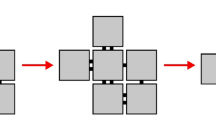Abstract
In this paper, we present high-level overviews of tile-based self-assembling systems capable of producing complex, infinite, aperiodic structures known as discrete self-similar fractals. Fractals have a variety of interesting mathematical and structural properties, and by utilizing the bottom-up growth paradigm of self-assembly to create them we not only learn important techniques for building such complex structures, we also gain insight into how similar structural complexity arises in natural self-assembling systems. Our results fundamentally leverage hierarchical assembly processes, and use as building blocks square “tile” components which are capable of activating and deactivating their binding “glues” a constant number of times each, based only on local interactions. We provide the first constructions capable of building arbitrary discrete self-similar fractals at scale factor 1, and many at temperature 1 (i.e. “non-cooperatively”), including the Sierpinski triangle.
























Similar content being viewed by others
Notes
In this paper we refer only to “strict” self-assembly, wherein a shape is made by placing tiles only within the domain of the shape, as opposed to “weak” self-assembly where a pattern representing the shape can be formed embedded within a framework of additional tiles.
Please note that by the generalized construction in the proof of Theorems 2 and 3, the same result holds but with junk assemblies of size \(\le 2\). However, we present this result and construction with its full details and all tile types and signals explicitly displayed here and in Hendricks et al. (2016b) because we feel that the simplifications used for this version are easier to follow.
References
Barth K, Furcy D, Summers SM, Totzke P (2014) Scaled tree fractals do not strictly self-assemble. In: Unconventional computation & natural computation (UCNC) 2014, University of Western Ontario, London, Ontario, Canada, July 14–18, 2014, pp 27–39
Cannon S, Demaine ED, Demaine ML, Eisenstat S, Patitz MJ, Schweller RT, Summers SM, Winslow A (2013) Two hands are better than one (up to constant factors): self-assembly in the 2ham vs. atam. In: Portier N, Wilke T (eds) STACS, vol. 20 of LIPIcs, pp 172–184. Schloss Dagstuhl - Leibniz-Zentrum fuer Informatik
Chalk CT, Fernandez DA, Huerta A, Maldonado MA, Schweller RT, Sweet L (2015) Strict self-assembly of fractals using multiple hands. Algorithmica 76(1):195–224
Cheng Q, Aggarwal G, Goldwasser MH, Kao M-Y, Schweller RT, de Espanés PM (2005) Complexities for generalized models of self-assembly. SIAM J Comput 34:1493–1515
Demaine ED, Demaine ML, Fekete SP, Ishaque M, Rafalin E, Schweller RT, Souvaine DL (2008) Staged self-assembly: nanomanufacture of arbitrary shapes with \({O}(1)\) glues. Nat Comput 7(3):347–370
Fochtman T, Hendricks J, Padilla JE, Patitz MJ, Rogers TA (2013) Signal transmission across tile assemblies: 3D static tiles simulate active self-assembly by 2D signal-passing tiles. Technical Report 1306.5005, Computing Research Repository
Hendricks J, Olsen M, Patitz MJ, Rogers TA, Thomas H (2016) Hierarchical self-assembly of fractals with signal-passing tiles (extended abstract). In: Proceedings of the 22nd international conference on DNA computing and molecular programming (DNA 22), Ludwig-Maximilians-Universitt, Munich, Germany, September 4–8, pp 82–97
Hendricks J, Olsen M, Patitz MJ, Rogers TA, Thomas H (2016) Hierarchical self-assembly of fractals with signal-passing tiles. Technical Report 1606.01856, Computing Research Repository
Hendricks J, Opseth J (2017) Self-assembly of 4-sided fractals in the two-handed tile assembly model. In: Proceedings of the 16th annual Conference on unconventional computation and natural computation (UCNC 2017), Fayetteville, Arkansas, USA, June 5–9, pp 113–128
Hendricks J, Patitz MJ, Rogers TA (2015) Replication of arbitrary hole-free shapes via self-assembly with signal-passing tiles (extended abstract). In: Calude CS, Dinneen MJ (eds), Proceedings of 14th international conference unconventional computation and natural computation, UCNC 2015, Auckland, New Zealand, August 30–September 3, 2015, vol. 9252 of lecture notes in computer science. Springer, pp 202–214
Jonoska N, Karpenko D (2014) Active tile self-assembly, part 1: universality at temperature 1. Int J Found Comput Sci 25(02):141–163
Jonoska N, Karpenko D (2014) Active tile self-assembly, part 2: self-similar structures and structural recursion. Int J Found Comput Sci 25(02):165–194
Keenan A, Schweller R, Zhong X (2015) Exponential replication of patterns in the signal tile assembly model. Nat Comput 14(2):265–278
Lathrop JI, Lutz JH, Summers SM (2009) Strict self-assembly of discrete Sierpinski triangles. Theoret Comput Sci 410:384–405
Lutz JH, Shutters B (2012) Approximate self-assembly of the Sierpinski triangle. Theory Comput Syst 51(3):372–400
Padilla JE, Patitz MJ, Schweller RT, Seeman NC, Summers SM, Zhong X (2014) Asynchronous signal passing for tile self-assembly: fuel efficient computation and efficient assembly of shapes. Int J Found Comput Sci 25(4):459–488
Padilla JE, Sha R, Kristiansen M, Chen J, Jonoska N, Seeman NC (2015) A signal-passing DNA-strand-exchange mechanism for active self-assembly of dna nanostructures. Angew Chem Int Ed 54:5939–5942
Patitz MJ, Summers SM (2010) Self-assembly of discrete self-similar fractals. Nat Comput 1:135–172
Winfree E (1998) Algorithmic self-assembly of DNA. Ph.D. thesis, California Institute of Technology
Acknowledgements
Matthew J. Patitz research was supported in part by National Science Foundation Grant CCF-1422152. Trent A. Rogers research was supported by the National Science Foundation Graduate Research Fellowship Program under Grant No. DGE-1450079, and National Science Foundation Grant CCF-1422152.
Author information
Authors and Affiliations
Corresponding author
Rights and permissions
About this article
Cite this article
Hendricks, J., Olsen, M., Patitz, M.J. et al. Hierarchical self-assembly of fractals with signal-passing tiles. Nat Comput 17, 47–65 (2018). https://doi.org/10.1007/s11047-017-9663-9
Published:
Issue Date:
DOI: https://doi.org/10.1007/s11047-017-9663-9




